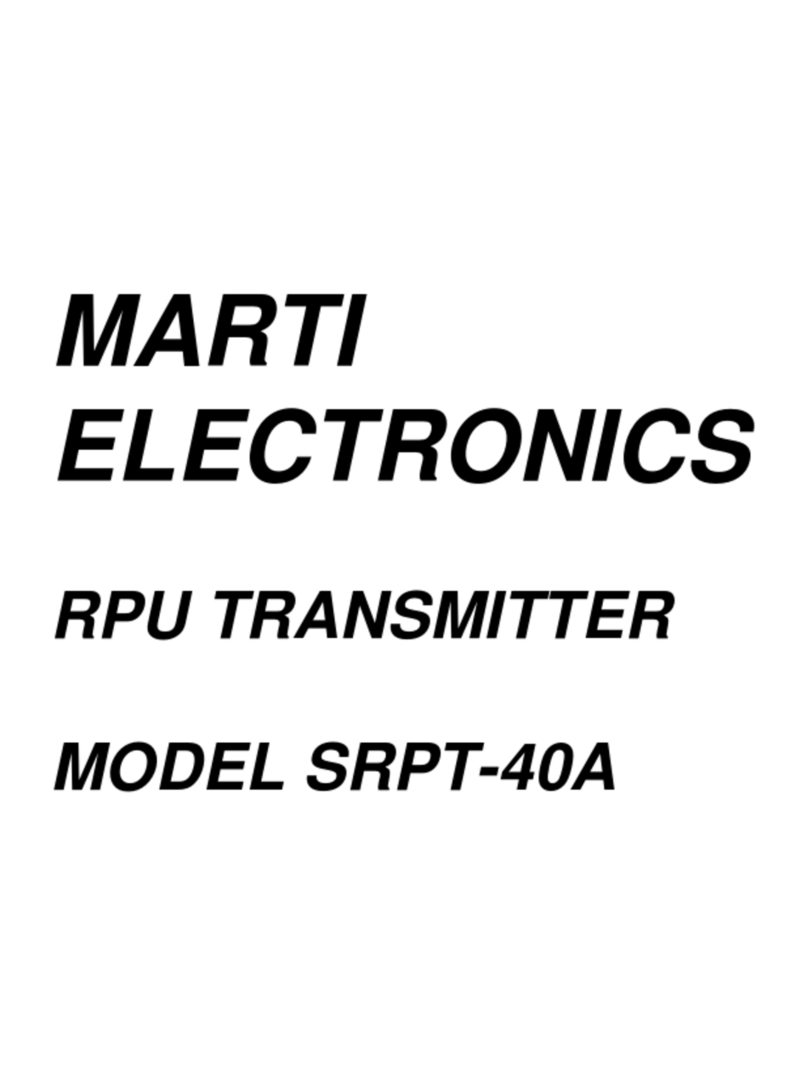
8/7/2003
2
The Marti Models SRPT-30/40A are wide-band – high power RPU Transmitters designed to operate in the Remote
Pick-Up Broadcast Service as defined in Part 74, Subpart D, of the FCC Rules and Regulations. The SRPT-30 replaces
the Marti RPT-30 series of RPU’s. Like its predecessor, the SRPT-30 has two frequency channels and a four-input
mixer for mic/line audio. Unlike the RPT-30, the SRPT-30 uses synthesizer technology (not to be confused with
frequency agile) instead of the discrete crystal technology. Also the SRPT-30 is equipped with a wide-band power
amplifier that has a power output up to 30 watts that can be adjusted from the front panel. This, combined with the wide-
band synthesizer, benefits the operator in the following ways: (1) Frequency separation between F1 and F2 frequency
can be up to 50 MHz and (2) No RF tuning required.
The SRPT-40A also uses synthesizer technology with a wide-band power amplifier and requires no tuning. It is
frequency agile up to 50 MHz with a front-panel adjustable output power up to 60 watts in some models. The frequency
can be “dialed in” from the front panel and will automatically tune precisely to all frequencies divisible by 5 KHz or
6.25 KHz increments. It will also tune to within ±.00015% tolerance of most other frequencies not divisible by 5 KHz or
6.25 KHz increments. Finally, the user may operate the SRPT-40A in channel mode where he may store and recall up to
10 frequencies.
Refer to the SPECIFICATIONS & ORDERING section for a listing of available frequency ranges and power
models. These transmitters, when used with their recommended companion receiver, provide a remote broadcast link
having audio quality not approached by conventional voice communication radio equipment. The SRPT-30/40A
transmitters operate from 110-120 VAC or 220-240 VAC (manually switched internally), 50/60 Hz. The transmitters
can also operate on 12-15 VDC or 15-30 VDC battery (or external supply) in fixed, portable, or mobile, service. Four
audio input channels are provided with individual mixing gain controls. A meter and selector switch are provided for
monitoring forward and reverse power, power supply voltage, PA current and audio compression.
SRPT-30/40A Features:
·Four balanced microphone mixing inputs, one switchable to balanced line level
·No RF tuning required
·Switching Power Supply operates on any AC voltage from 110-120 VAC or 220-240 VAC
(manually switched internally), 50/60 Hz
·LEDs indicate High VSWR, Over-Temperature, AFC Lock, and Transmit
·Illuminated VU Meter for displaying Forward/Reverse Power, PA current, Power Supply
voltage, and Audio Compression
·Output power adjustable from front panel
·External 12-15 VDC or 15-30 VDC supply capability and external transmit control
·When operating on external 12-15 VDC supply, RPU will still remained locked for
external supply voltages as low as 7 VDC (Max power will de-rate linearly below 12 VDC)
·Fully suppresses external voltage supply noise such as car alternator
·High speed imbedded µ-controller to perform the following additional features:
·Power held constant over frequency, temperature, and voltage change
·High PA temp and VSWR warning indicators
·Auto frequency re-lock due to power outage
·Auto fold-back and recover due to high VSWR
·Auto shutdown due to very high PA temp – auto recover after cool down
·Auto shutdown due to open/short-output – auto recover
·Can operate as TSL (Models SRPT30-450T and SRPT40A-450T)






























